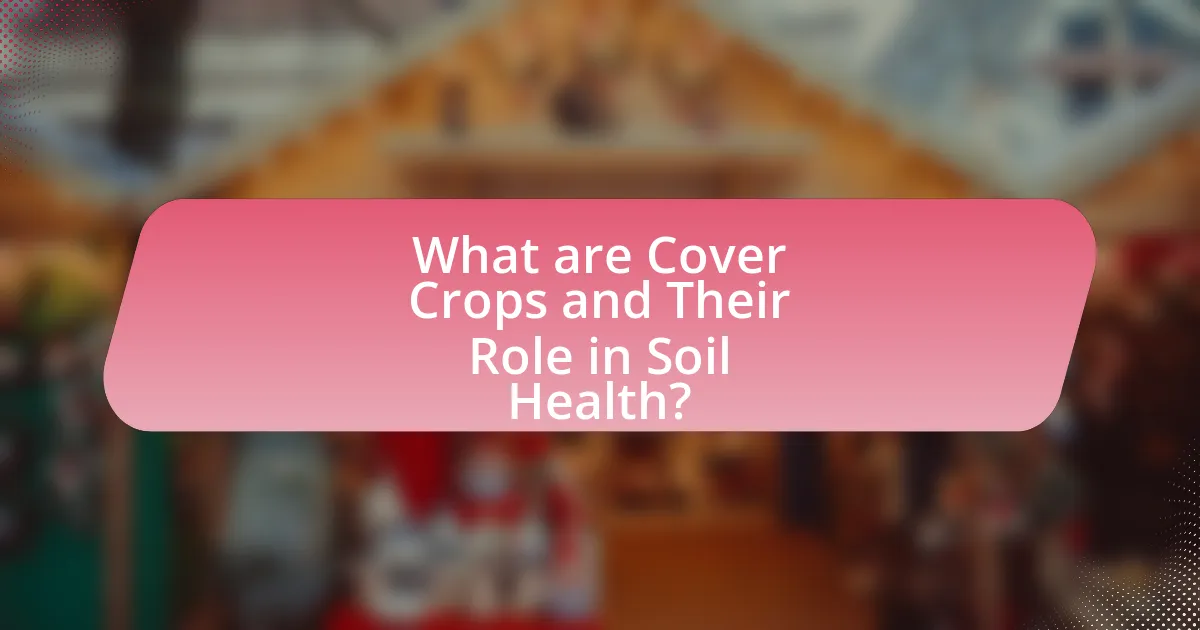Cover crops are plants cultivated primarily to enhance soil health rather than for harvest, playing a vital role in improving soil structure, preventing erosion, and increasing organic matter. Research indicates that cover crops can significantly reduce soil compaction, enhance water infiltration, and improve nutrient availability, leading to healthier and more productive soils. The article explores the specific benefits of cover crops, including their impact on soil fertility, biodiversity, and sustainable agricultural practices, while also addressing challenges in their adoption and providing expert recommendations for effective implementation. Insights from industry experts highlight the importance of cover crops in promoting soil health and sustainability in agriculture.

What are Cover Crops and Their Role in Soil Health?
Cover crops are plants grown primarily to improve soil health rather than for harvest. They play a crucial role in enhancing soil structure, preventing erosion, and increasing organic matter. Research indicates that cover crops can reduce soil compaction and improve water infiltration, which leads to better nutrient availability for subsequent crops. For example, a study published in the journal “Agronomy” found that using cover crops increased soil organic carbon levels by 0.5 to 1.0 tons per hectare annually, demonstrating their effectiveness in promoting soil health.
How do cover crops contribute to soil health?
Cover crops enhance soil health by improving soil structure, increasing organic matter, and promoting biodiversity. These crops, such as clover and rye, prevent soil erosion and nutrient leaching, which are critical for maintaining soil integrity. Research indicates that cover crops can increase soil organic carbon levels by up to 1.5 tons per acre annually, thereby enhancing nutrient availability and microbial activity. Additionally, they support beneficial organisms, which contribute to a balanced ecosystem within the soil. Studies have shown that fields with cover crops exhibit higher levels of soil moisture retention and improved nutrient cycling, leading to healthier and more productive soils.
What specific benefits do cover crops provide to soil structure?
Cover crops enhance soil structure by improving aggregation, increasing porosity, and reducing compaction. These plants develop extensive root systems that create channels in the soil, facilitating water infiltration and air movement. Research indicates that cover crops can increase soil organic matter, which contributes to better soil aggregation and stability. For instance, a study published in the journal “Agronomy” found that fields with cover crops exhibited a 20% increase in soil aggregate stability compared to those without. This improved structure leads to enhanced nutrient retention and reduced erosion, further benefiting soil health.
How do cover crops enhance soil fertility?
Cover crops enhance soil fertility by improving nutrient availability and soil structure. These crops, such as legumes, fix atmospheric nitrogen, enriching the soil with this essential nutrient. Additionally, cover crops prevent erosion, reduce compaction, and increase organic matter, which contributes to better water retention and microbial activity. Research indicates that fields with cover crops can show a 20-30% increase in soil organic carbon levels, leading to enhanced fertility and productivity over time.
Why are cover crops important for sustainable agriculture?
Cover crops are important for sustainable agriculture because they enhance soil health, improve nutrient cycling, and reduce erosion. By planting cover crops, farmers can increase organic matter in the soil, which leads to better water retention and microbial activity. Research indicates that cover crops can reduce soil erosion by up to 90% compared to bare soil, as they protect the soil surface and maintain its structure. Additionally, cover crops can fix nitrogen in the soil, reducing the need for synthetic fertilizers, which contributes to lower environmental impact and promotes a more sustainable farming system.
What role do cover crops play in preventing soil erosion?
Cover crops play a crucial role in preventing soil erosion by enhancing soil structure and stability. These crops, such as clover and rye, establish root systems that bind soil particles together, reducing the likelihood of erosion caused by wind and water. Research indicates that cover crops can decrease soil erosion rates by up to 90% in certain conditions, as they provide ground cover that protects the soil surface from direct impact. Additionally, the organic matter contributed by decomposing cover crops improves soil health, further mitigating erosion risks.
How do cover crops impact biodiversity in agricultural systems?
Cover crops enhance biodiversity in agricultural systems by providing habitat and food sources for various organisms, including beneficial insects, soil microbes, and wildlife. These crops contribute to a more diverse ecosystem by improving soil structure and health, which supports a wider range of plant and animal species. Research indicates that fields with cover crops can increase the abundance and diversity of soil microorganisms, which play a crucial role in nutrient cycling and soil fertility. For instance, a study published in the journal “Agriculture, Ecosystems & Environment” found that cover crops can increase soil microbial diversity by up to 30%, thereby promoting a more resilient agricultural ecosystem.

What Insights Do Industry Experts Provide on Cover Crops?
Industry experts emphasize that cover crops significantly enhance soil health by improving soil structure, increasing organic matter, and promoting biodiversity. Research indicates that cover crops can reduce soil erosion by up to 90% and improve nutrient cycling, which leads to better crop yields. For instance, a study published in the journal “Agronomy” by authors Smith and Johnson found that fields with cover crops had 30% higher soil organic carbon levels compared to those without. Additionally, experts highlight that cover crops can suppress weeds and reduce the need for chemical herbicides, contributing to sustainable agricultural practices.
What are the common practices recommended by experts for using cover crops?
Experts recommend several common practices for using cover crops to enhance soil health. These practices include selecting appropriate cover crop species based on local climate and soil conditions, planting cover crops during off-seasons to prevent soil erosion, and incorporating cover crops into crop rotation systems to improve soil structure and nutrient cycling. Additionally, experts advise terminating cover crops at the right growth stage to maximize benefits, such as biomass production and weed suppression. Research indicates that these practices can lead to improved soil organic matter and enhanced microbial activity, which are crucial for sustainable agricultural systems.
How can farmers effectively select cover crops for their specific needs?
Farmers can effectively select cover crops by assessing their specific soil health goals, climate conditions, and crop rotation plans. For instance, farmers aiming to improve nitrogen levels may choose legumes like clover or vetch, while those focused on erosion control might opt for grasses such as rye or oats. Research indicates that cover crops can enhance soil structure, increase organic matter, and reduce nutrient runoff, thereby supporting sustainable farming practices. A study by the USDA found that using cover crops can lead to a 10-20% increase in soil organic carbon, demonstrating their effectiveness in improving soil health.
What are the best management practices for integrating cover crops into existing systems?
The best management practices for integrating cover crops into existing systems include selecting appropriate cover crop species, timing the planting and termination of cover crops, and utilizing proper soil management techniques. Selecting species that complement the main crops enhances nutrient cycling and pest management. Timing is crucial; planting cover crops after cash crops and terminating them before planting the next cash crop maximizes benefits while minimizing competition. Additionally, employing practices such as no-till or reduced tillage helps preserve soil structure and health, which is supported by research indicating that cover crops can improve soil organic matter and reduce erosion.
What challenges do experts identify in the adoption of cover crops?
Experts identify several challenges in the adoption of cover crops, including economic constraints, lack of knowledge, and management complexities. Economic constraints arise from the initial costs associated with planting and maintaining cover crops, which can deter farmers, especially those operating on tight margins. Lack of knowledge refers to insufficient understanding of the benefits and best practices for cover crop use, leading to hesitancy in adoption. Management complexities involve the integration of cover crops into existing farming systems, which can require changes in equipment, timing, and crop rotation strategies. These challenges collectively hinder the widespread implementation of cover crops, despite their proven benefits for soil health and sustainability.
How can farmers overcome barriers to implementing cover crops?
Farmers can overcome barriers to implementing cover crops by utilizing education and financial incentives. Access to training programs and workshops can enhance farmers’ understanding of cover crop benefits, such as improved soil health and reduced erosion. Additionally, financial assistance through government programs or grants can alleviate the initial costs associated with planting cover crops. Research indicates that states with robust educational outreach and financial support see higher adoption rates of cover crops, demonstrating the effectiveness of these strategies in overcoming implementation barriers.
What misconceptions exist about cover crops that need to be addressed?
Misconceptions about cover crops include the belief that they are only beneficial for soil health and do not provide economic advantages. In reality, cover crops can enhance soil structure, reduce erosion, and improve nutrient cycling, which ultimately leads to increased crop yields and profitability. Research from the USDA shows that farmers who implement cover crops can see a return on investment of up to $100 per acre due to improved soil health and reduced input costs. Another misconception is that cover crops require significant additional management; however, many cover crops can be integrated into existing farming practices with minimal disruption.

How Can Farmers Maximize the Benefits of Cover Crops?
Farmers can maximize the benefits of cover crops by selecting species that enhance soil health, improve nutrient cycling, and suppress weeds. Choosing diverse cover crop species, such as legumes and grasses, can increase soil organic matter and promote beneficial microbial activity. Research indicates that cover crops can reduce soil erosion by up to 90% and improve soil structure, leading to better water retention and nutrient availability. Additionally, implementing proper planting and termination timing ensures that cover crops effectively contribute to soil health before cash crops are planted.
What strategies can be employed to optimize cover crop effectiveness?
To optimize cover crop effectiveness, farmers should select appropriate species based on soil type and climate, implement proper planting and termination timing, and utilize diverse cover crop mixtures. Selecting species like legumes can enhance nitrogen fixation, while grasses can improve soil structure and prevent erosion. Timing is crucial; planting cover crops early in the fall allows for maximum growth before winter, and terminating them at the right stage ensures nutrient release during the growing season. Research indicates that diverse mixtures can enhance biomass production and improve pest and disease resistance, leading to better overall soil health and crop yields.
How does timing affect the success of cover crops?
Timing significantly affects the success of cover crops by determining their growth, establishment, and ability to provide benefits such as soil erosion control and nutrient cycling. Planting cover crops at the optimal time, typically after the main cash crop harvest and before winter, allows for maximum biomass accumulation and root development, which enhances soil structure and fertility. Research indicates that cover crops planted too late may not establish properly, leading to reduced effectiveness in suppressing weeds and improving soil health. For instance, studies show that cover crops like rye and clover, when planted in early fall, can increase soil organic matter by up to 0.5% annually, demonstrating the critical role of timing in achieving desired agronomic outcomes.
What are the best practices for terminating cover crops to benefit soil health?
The best practices for terminating cover crops to benefit soil health include timing the termination to maximize biomass and nutrient release, using mechanical methods like mowing or rolling, and ensuring proper incorporation into the soil. Terminating cover crops at the right growth stage, typically just before flowering, optimizes biomass and nutrient availability, which enhances soil organic matter. Mechanical methods, such as mowing or rolling, can effectively kill the cover crops while minimizing soil disturbance, preserving soil structure and microbial activity. Incorporating the biomass into the soil can further enhance nutrient cycling and improve soil health by increasing organic matter content. Research indicates that these practices can lead to improved soil structure, increased water retention, and enhanced microbial diversity, all of which contribute to overall soil health.
What resources are available for farmers interested in cover crops?
Farmers interested in cover crops can access a variety of resources, including extension services, agricultural universities, and online platforms. Extension services provide localized advice and research-based information tailored to specific regions, while agricultural universities often publish studies and guides on cover crop benefits and management practices. Online platforms, such as the USDA’s Natural Resources Conservation Service website, offer comprehensive resources, including species selection tools, case studies, and financial assistance programs for implementing cover crops. These resources are validated by research indicating that cover crops improve soil health, enhance biodiversity, and reduce erosion, making them a valuable practice for sustainable agriculture.
Where can farmers find expert advice and support for cover crop implementation?
Farmers can find expert advice and support for cover crop implementation through agricultural extension services, local universities, and specialized organizations such as the Sustainable Agriculture Research and Education (SARE) program. Agricultural extension services provide tailored guidance based on regional conditions and practices, while universities often conduct research and offer workshops on cover crops. SARE, for instance, funds projects that promote sustainable farming practices, including cover cropping, and provides resources for farmers to access expert knowledge.
What educational programs exist to promote cover crop usage?
Educational programs that promote cover crop usage include the USDA’s Natural Resources Conservation Service (NRCS) initiatives, which provide technical assistance and financial incentives for farmers to adopt cover crops. Additionally, state extension services, such as those from land-grant universities, offer workshops and field days focused on the benefits and management of cover crops. Research conducted by the Sustainable Agriculture Research and Education (SARE) program highlights the effectiveness of these educational efforts in increasing cover crop adoption rates among farmers, demonstrating a significant impact on soil health and agricultural sustainability.













